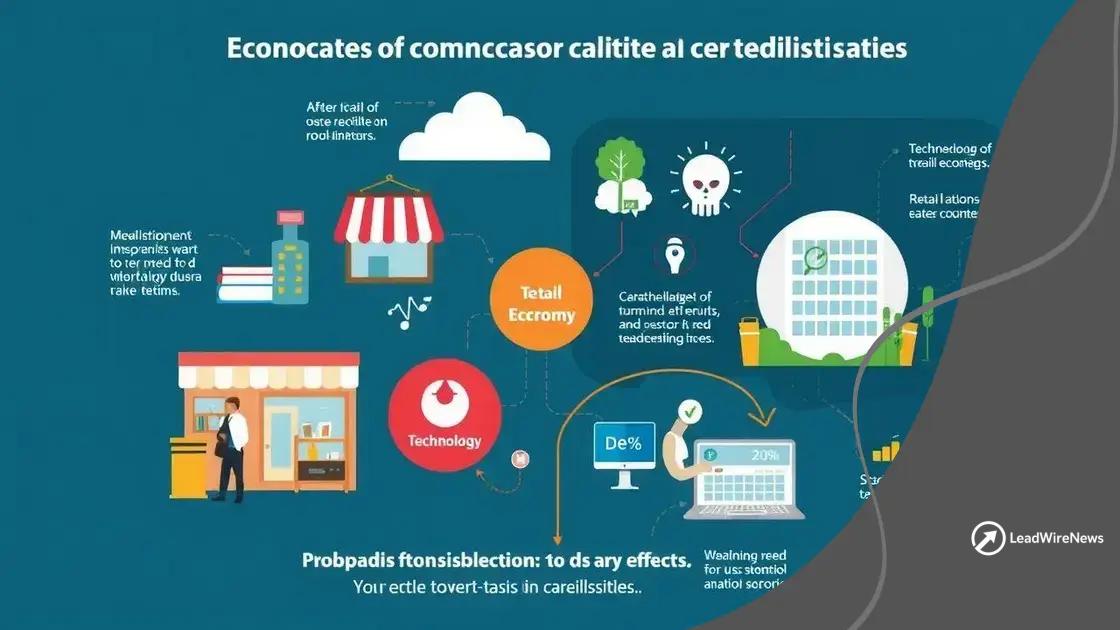Discussions on economic stimulus measures that matter

Anúncios
Discussions on economic stimulus measures focus on government policies designed to increase economic activity through targeted investments, financial aid, and strategic coordination among sectors to promote recovery and growth.
Discussions on economic stimulus measures play a vital role in shaping our economic recovery. Have you ever wondered how these measures impact your daily life? This article dives into the various facets of economic stimulus and its significance.
Anúncios
Understanding economic stimulus measures
Understanding economic stimulus measures is crucial for grasping how governments tackle economic downturns. These measures are designed to boost spending and revive economic activity.
What are Economic Stimulus Measures?
At their core, economic stimulus measures are policies implemented by governments to stimulate economic growth. They take various forms, such as tax cuts, direct payments, and increased government spending. By injecting funds into the economy, these measures aim to enhance consumer confidence and spending.
Types of Stimulus Packages
- Fiscal Policy Measures: These include changes in government spending and taxation.
- Monetary Policy Adjustments: Central banks may lower interest rates or implement quantitative easing.
- Direct Financial Aid: Payments made to individuals or businesses to support them during economic hardships.
When implemented effectively, these measures can lead to increased job creation and reduced unemployment rates. For instance, during a recession, a government might issue stimulus checks to households, allowing them to spend on necessities and support local businesses.
Anúncios
Effects on Different Economic Sectors
Diverse sectors respond uniquely to economic stimulus measures. For instance, the retail sector often sees immediate effects from consumer spending, while infrastructure projects may take longer to influence the economy. Understanding these differences can help predict which sectors might thrive during and after stimulus implementation.
Moreover, sectors like technology or clean energy can benefit from targeted stimulus funds. This shift emphasizes the need for strategic planning in policy-making.
By grasping the types and impacts of these measures, we gain a better perspective on their role in shaping economic recovery.
Types of stimulus packages available
Understanding the types of stimulus packages available is essential to comprehend how governments respond to economic challenges. These packages come in various forms and serve different purposes, aiming to revitalize the economy during tough times.
Fiscal Stimulus Packages
Fiscal stimulus packages typically involve changes in government spending and taxes. They can help boost demand by putting more money into the hands of consumers and businesses. For example, a government might decide to increase spending on infrastructure projects to create jobs and stimulate local economies.
Monetary Stimulus Packages
Monetary stimulus measures are often carried out by central banks. These actions include lowering interest rates to encourage borrowing or conducting quantitative easing, where the central bank buys financial assets to increase the money supply. These measures can help improve liquidity in the market and promote borrowing.
- Lowered interest rates: Make loans cheaper for businesses and consumers.
- Quantitative easing: Increases the money supply to stimulate the economy.
- Credit easing: Aims to improve the functioning of financial markets.
Both fiscal and monetary measures play vital roles in mitigating the effects of economic downturns. By using these stimulus packages strategically, governments can address immediate needs while laying the groundwork for long-term recovery.
Another category of stimulus is direct financial aid, which can come in the form of stimulus checks, unemployment benefits, or aid for specific sectors like agriculture or tourism. Such direct support helps individuals and businesses navigate through challenging times.
Combined Approaches
Often, governments use a combination of fiscal and monetary measures to create a comprehensive strategy. This approach enhances the overall impact of the stimulus, ensuring that both immediate and longer-term economic goals are met. It’s important to explore how these different types interact to create a balanced response to economic needs.
Effects on different sectors of the economy

The effects on different sectors of the economy from stimulus measures can vary significantly. Each sector may respond differently based on its specific needs and circumstances. Understanding these impacts is vital for predicting how economic recovery will unfold.
Consumer Goods Sector
The consumer goods sector often sees immediate benefits from stimulus packages. When households receive direct payments, they tend to spend this money on essential items. This increase in spending can help boost sales for retail businesses and support jobs in this sector.
Service Industry
Stimulus measures greatly affect the service industry, which includes sectors like hospitality and entertainment. Governments might provide specific assistance to businesses such as restaurants and hotels, helping them survive during downturns. This targeted support enables these businesses to retain employees and continue operating.
- Job retention: Financial aid can help businesses keep staff on payroll.
- Increased customer visits: Lower costs can lead to more people dining out or traveling.
- Revitalization of tourism: Support for the tourism sector can attract visitors back.
The healthcare sector also experiences notable effects from stimulus efforts. Increased government spending can lead to better funding for healthcare facilities, enabling them to expand services and improve patient care. In times of crisis, this sector plays a vital role in responding effectively to public health needs.
The impact on the technology sector has been increasingly significant as well. Stimulus investments in digital infrastructure can boost tech companies, providing them with new opportunities to innovate. As businesses adapt to a digital landscape, demand for technology services grows.
Challenges in Implementation
While the effects on different sectors of the economy can be positive, challenges persist. Some sectors may not benefit equally. For instance, the manufacturing sector may face delays and disruptions in supply chains, affecting its recovery. Addressing these disparities is vital to achieving a balanced economic rebound.
Challenges in implementing stimulus measures
The challenges in implementing stimulus measures can pose significant hurdles for governments and economies. While these measures aim to support various sectors, several issues can arise during execution.
Coordination Among Agencies
One major challenge is ensuring effective coordination among different government agencies. When multiple organizations are involved in distributing aid, communication can suffer. This delay can result in funds not reaching those who need them most.
Targeting the Right Groups
Another challenge lies in identifying the right groups to receive benefits. Some individuals or businesses may fall through the cracks due to outdated data or miscommunication. This misalignment can lead to inequitable distribution of resources.
- Inaccurate data: Without up-to-date information, targeting can become ineffective.
- Slow rollout: Time-consuming processes can delay assistance to those who need it urgently.
- Political factors: Decisions can be influenced by political agendas, complicating proper implementation.
Economic conditions can create additional barriers. For example, high unemployment rates or recession can increase the demand for aid, straining the system and causing delays. As more people request assistance, the infrastructure may struggle to keep up.
Another noteworthy issue is misinformation. When accurate information about stimulus measures is not clearly communicated, confusion can arise. People may not know how to apply for assistance or whether they qualify, leading to low participation rates.
Monitoring and Evaluation
Monitoring and evaluating the effectiveness of the measures can be challenging. Governments need to assess whether the funds are making a real difference. Without proper oversight, it’s difficult to determine if adjustments are necessary.
Future outlook for stimulus strategies
The future outlook for stimulus strategies is a crucial topic as economies work to recover and grow. Governments are learning from past experiences and adapting their approaches to ensure better results in the future.
Adapting to Changing Economic Conditions
As economic conditions evolve, so must stimulus strategies. For example, if inflation rises, governments might need to focus on controlling prices while still encouraging growth. This requires a delicate balance in policy-making to ensure that the measures implemented are effective.
Long-Term Investment Focus
In the coming years, there is likely to be a stronger emphasis on long-term investments. Governments may target infrastructure improvements, education, and technology to build a resilient economy. These investments can lead to sustainable growth and help create a prosperous future.
- Green initiatives: Investments in renewable energy can lead to job creation and environmental benefits.
- Technology upgrades: Enhancing digital infrastructure can strengthen economic foundations.
- Workforce development: Training programs can better prepare workers for future jobs.
Moreover, there may be an increased focus on data-driven policies. Using advanced analytics can help governments identify effective strategies tailored to specific needs in various sectors. By investing in data collection and analysis, they can respond more efficiently to challenges.
The role of public-private partnerships is also expected to grow. Collaborating with private sector entities can enhance the effectiveness of stimulus measures. These partnerships can lead to innovative solutions and the efficient distribution of resources.
Global Collaboration
As economies are interconnected, international cooperation will likely play a vital role in future stimulus strategies. Countries may work together to address global challenges, such as pandemics and climate change, by sharing best practices and resources.
FAQ – Frequently Asked Questions about Economic Stimulus Measures
What are economic stimulus measures?
Economic stimulus measures are government policies aimed at increasing economic activity by boosting consumer spending and business investment.
How do stimulus packages impact different sectors of the economy?
Stimulus packages can create immediate benefits, particularly in consumer goods and service sectors, while other areas like manufacturing might face delays.
What challenges do governments face in implementing stimulus measures?
Governments struggle with coordinating assistance, identifying the right beneficiaries, and ensuring timely distribution of funds.
What is the future outlook for stimulus strategies?
The future will likely focus on long-term investments and data-driven policies, fostering public-private partnerships and global cooperation for better recovery.